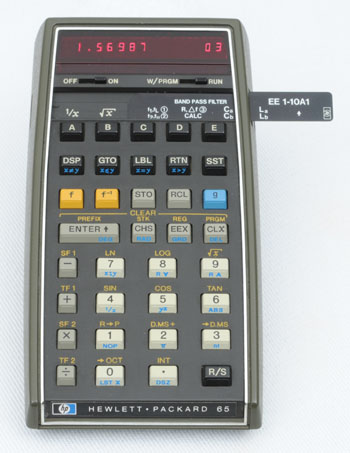The HP-80, HP-45, and HP-65, Pocket Calculators


 |
The HP 80 |
The HP 80 was announced in the May 1973 Hewlett Packard Journal as "A Pocket-Sized Answer Machine for Business and Finance."
The HP-80 is a preprogrammed computer / calculator designed specifically for financial and business calculations. The HP-80 looks very much like the HP-35, HP's first pocket calculator, which was designed for engineering and scientific work.
In fact, the HP-80 and the HP-35 operate the same arithmetically. But the design objectives for the HP-80 were less technical and more problem oriented. Over 30 hard-wired programs were implemented in the HP-80. These programs essentially replace all of the commonly used financial tables, such as compound interest, annuities, bonds, and so on. Answers are displayed to as many as six decimal places.
 |
The HP 45 |
Introduced a short time after the HP 80, the HP 45 was an improved version of the HP 35. Sometimes nick-named the "Slide Rule +", the HP 45 was the first to have a Shift Key. It was also the first pocket calculator to have nine storage registers.
Another improvement brought by the HP 45 was a formatted display which added both fixed and scientific displays, with a choice of significant digits.
The HP 45 was also the first pocket calculator that including a timer. However, HP did not reveal it as a user feature because the timing reference, based on a simple LC circuit, was quite inaccurate. Once in timer mode, the current time was stored in the corresponding register by pressing key 1 to 9.
The HP 55, introduced in 1975, would be the first pocket calculator claiming an accurate timer function. This was made possible by a quartz crystal time reference implemented within the calculator circuitry.
The "Personal Computer" long before that term had become common, was the title in the May 1974 issue of the Hewlett Packard Journal. Almost entirely dedicated to the birth of the HP 65, Introduction to the first article was written by Chung C. Tung:
"AN ENGINEER OR SCIENTIST in need of an on-the-spot answer in the laboratory, a pilot making an in-flight course correction, a surveyor running a traverse in the field, a businessman estimating returns-on-investment during a conference, a physician evaluating patient data-it isn't difficult to think of everyday examples of people whose professions require certain types of calculations over and over again. Were one available, a computer or programmable calculator would obviously be of great assistance to such people. Unfortunately, you can't carry one of those around in your pocket, CAN YOU ? "
 |
| The HP 65 in Original Box with User Guide and Libraries |
 |
The HP 65 |
Just 18 months after the first pocket calculator, HP introduced the HP 65 that was programmable with a magnetic card reader/writer.
Although the HP-65 was designed to operate in a logical, easy-to-learn way, it was capable of sophisticated computations. It had 51 built-in mathematical functions and data manipulation operations, a four register operational stack, nine addressable data registers, and five user-definable keys. It ran programs that had as many as 100 steps. There were two program flags and four comparison tests for program branching.
These capabilities allowed the HP-65 to be used three ways:
1. As a user-programmed calculator, the HP-65 lets you program up to five functions callable from the keyboard or by other programmed functions; conditional skips based on logic comparisons; and branches. You can also edit any program and save it on a magnetic card for future use.
2. With pre-recorded program cards from Hewlett-Packard, the HP 65 can be used by anyone to solve complex problems in such fields as electrical engineering, statistics, mathematics, medicine, finance, marine navigation, surveying and aviation. Simply select the right pre-recorded program card, and start the program.
3. Even as a keyboard operated calculator, the HP-65 can perform all trig functions in three angle modes, handle logarithms, and permit register arithmetic. Other pre-programmed functions include: factorial, polar/rectangular coordinate conversions, square-root, square reciprocal, decimal/octal integer conversions, and the ability to add or subtract degrees/minutes/seconds.
A catalog of Application Pacs, was available immediately upon the introduction of the HP 65. Each application pac contained up to 40 pre-recorded program cards, and a user guide describing, for each program, the mathematical formula used, the different program steps, and the way to input the data into the calculator memory. Picture below shows a typical example of such an application program, one among the 29 included in the "AVIATION PAC 1" library.
 |
| One Among the 29 Programs Solved by the HP 65 Aviation Application Pac |